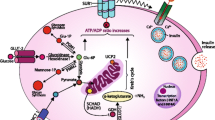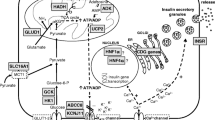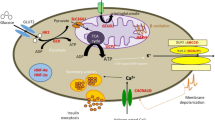Abstract
Hypoglycaemia in children can be a life-threatening situation that needs to be assessed rigorously in order to treat efficiently and avoid relapse that can be responsible for cerebral damage. The diagnosis of impairment in glucose homeostasis requires the knowledge of the mechanisms regulating blood glucose concentration. The clinical history and presentation, when available, especially the timing of hypoglycaemia with respect to the last meal and some simple clinical and biological tests may allow diagnosing the vast majority of patients presenting with hypoglycaemia. Recently, new metabolic and endocrinologic genetic causes of hypoglycaemia have been identified that may give new insight to the complex mechanisms of glucose regulation and thus contribute to the discovery of new genes regulating glucose homeostasis. New diagnostic tests such as the 18-fluoro-Dopa PET-scan have also been recently developed.


Similar content being viewed by others
Abbreviations
- ATP::
-
Adenosine triphosphate
- BWS::
-
Beckwith-Wiedemann syndrome
- CDG::
-
Congenital disorders of glycosylation
- FAO::
-
Fatty acid oxidation
- FBS::
-
Fanconi-Bickel syndrome
- GDH::
-
Glutamate dehydrogenase
- GH::
-
Growth hormone
- GK::
-
Glucokinase
- GTP::
-
Guanosine triphosphate
- HI::
-
Hyperinsulinism
- HIHA::
-
Hyperinsulinism-hyperammoniemia syndrome
- IGF1::
-
Insuline-like growth factor 1
- MCT::
-
Mean chain triglycerides
- PET::
-
Positron emission tomography
- SCHAD::
-
Short chain 3-hydroxyacyl-CoA dehydrogenase deficiency
- TBG::
-
Thyroxin-binding globulin
References
Baujat G, Rio M, Rossignol S, Sanlaville D, Lyonnet S, Le Merrer M, Munnich A, Gicquel C, Cormier-Daire V, Colleaux L (2004) Paradoxical NSD1 mutations in Beckwith-Wiedemann syndrome and 11p15 anomalies in Sotos syndrome. Am J Hum Genet 74(4):715–720
Bitner-Glindzicz M, Lindley KJ, Rutland P, Blaydon D, Smith VV, Milla PJ, Hussain K, Furth-Lavi J, Cosgrove KE, Shepherd RM, Barnes PD, O’Brien RE, Farndon PA, Sowden J, Liu XZ, Scanlan MJ, Malcolm S, Dunne MJ, Aynsley-Green A, Glaser B (2000) A recessive contiguous gene deletion causing infantile hyperinsulinism, enteropathy and deafness identifies the Usher type 1C gene. Nat Genet 26(1):56–60
Bohles H, Sewell AA, Gebhardt B, Reinecke-Luthge A, Kloppel G, Marquardt T (2001) Hyperinsulinaemic hypoglycaemia–leading symptom in a patient with congenital disorder of glycosylation Ia (phosphomannomutase deficiency). J Inherit Metab Dis 24(8):858–862
Cohen MM Jr (2005) Beckwith-Wiedemann syndrome: historical, clinicopathological, and etiopathogenetic perspectives. Pediatr Dev Pathol 8(3):287–304
Cornblath M, Schwartz R, Aynsley-Green A, Lloyd JK (1990) Hypoglycemia in infancy: the need for a rational definition. A Ciba Foundation discussion meeting. Pediatrics 85(5):834–837
Cosgrove KE, Antoine MH, Lee AT, Barnes PD, de Tullio P, Clayton P, McCloy R, De Lonlay P, Nihoul-Fekete C, Robert JJ, Saudubray JM, Rahier J, Lindley KJ, Hussain K, Aynsley-Green A, Pirotte B, Lebrun P, Dunne MJ (2002) BPDZ 154 activates adenosine 5′-triphosphate-sensitive potassium channels: in vitro studies using rodent insulin-secreting cells and islets isolated from patients with hyperinsulinism. J Clin Endocrinol Metab 87(11):4860–4868
de Lonlay P, Cormier-Daire V, Amiel J, Touati G, Goldenberg A, Fournet JC, Brunelle F, Nihoul-Fekete C, Rahier J, Junien C, Robert JJ, Saudubray JM (2002) Facial appearance in persistent hyperinsulinemic hypoglycemia. Am J Med Genet 111(2):130–133
de Lonlay P, Cuer M, Vuillaumier-Barrot S, Beaune G, Castelnau P, Kretz M, Durand G, Saudubray JM, Seta N (1999) Hyperinsulinemic hypoglycemia as a presenting sign in phosphomannose isomerase deficiency: a new manifestation of carbohydrate-deficient glycoprotein syndrome treatable with mannose. J Pediatr 135(3):379–83
de Lonlay P, Simon-Carre A, Ribeiro MJ, Boddaert N, Giurgea I, Laborde K, Bellanne-Chantelot C, Verkarre V, Polak M, Rahier J, Syrota A, Seidenwurm D, Nihoul-Fekete C, Robert JJ, Brunelle F, Jaubert F (2006) Congenital hyperinsulinism: pancreatic [18F]fluoro-L-dihydroxyphenylalanine (DOPA) positron emission tomography and immunohistochemistry study of DOPA decarboxylase and insulin secretion. J Clin Endocrinol Metab 91(3):933–40
de Lonlay-Debeney P, Poggi-Travert F, Fournet JC, Sempoux C, Vici CD, Brunelle F, Touati G, Rahier J, Junien C, Nihoul-Fekete C, Robert JJ, Saudubray JM (1999) Clinical features of 52 neonates with hyperinsulinism. N Engl J Med 340(15):1169–1175
Dubois J, Brunelle F, Touati G, Sebag G, Nuttin C, Thach T, Nikoul-Fekete C, Rahier J, Saudubray JM (1995) Hyperinsulinism in children: diagnostic value of pancreatic venous sampling correlated with clinical, pathological and surgical outcome in 25 cases. Pediatr Radiol 25(7):512–516
Dunne MJ, Cosgrove KE, Shepherd RM, Aynsley-Green A, Lindley KJ (2004) Hyperinsulinism in infancy: from basic science to clinical disease. Physiol Rev 84(1):239–75
Fernandez-Marmiesse A, Salas A, Vega A, Fernandez-Lorenzo JR, Barreiro J, Carracedo A (2006) Mutation spectra of ABCC8 gene in Spanish patients with hyperinsulinism of infancy (HI). Hum Mutat 27(2):214
Glaser B, Kesavan P, Heyman M, Davis E, Cuesta A, Buchs A, Stanley CA, Thornton PS, Permutt MA, Matschinsky FM, Herold KC (1998) Familial hyperinsulinism caused by an activating glucokinase mutation. N Engl J Med 338(4):226–30
Hachisu M, Oda Y, Goto M, Kobayashi K, Saheki T, Ohura T, Noma S, Kitanaka S (2005) Citrin deficiency presenting with ketotic hypoglycaemia and hepatomegaly in childhood. Eur J Pediatr 164(2):109–10
Hardy OT, Hohmeier HE, Becker TC, Manduchi E, Doliba NM, Gupta RK, White P, Stoeckert CJ Jr, Matschinsky FM, Newgard CB, Kaestner KH (2007) Functional genomics of the beta-cell: short-chain 3-hydroxyacyl-coenzyme A dehydrogenase regulates insulin secretion independent of K+ currents. Mol Endocrinol 21(3):765–73
Hawdon JM (1999) Hypoglycaemia and the neonatal brain. Eur J Pediatr 158(suppl 1):S9–S12
Henneveld HT, van Lingen RA, Hamel BC, Stolte-Dijkstra I, van Essen AJ (1999) Perlman syndrome: four additional cases and review. Am J Med Genet 86(5):439–46
Henry I, Jeanpierre M, Barichard F, Serre JL, Mallet J, Turleau C, de Grouchy J, Junien C (1988) Duplication of HRAS1, INS, and IGF2 is not a common event in Beckwith-Wiedemann syndrome. Ann Genet 31(4):216–20
Hojlund K, Hansen T, Lajer M, Henriksen JE, Levin K, Lindholm J, Pedersen O, Beck-Nielsen H (2004) A novel syndrome of autosomal-dominant hyperinsulinemic hypoglycemia linked to a mutation in the human insulin receptor gene. Diabetes 53(6):1592–8
Hughes-Benzie R, Allanson J, Hunter A, Cole T (1992) The importance of differentiating Simpson-Golabi-Behmel and Beckwith-Wiedemann syndromes. J Med Genet 29(12):928
Jackson RS, Creemers JW, Farooqi IS, Raffin-Sanson ML, Varro A, Dockray GJ, Holst JJ, Brubaker PL, Corvol P, Polonsky KS, Ostrega D, Becker KL, Bertagna X, Hutton JC, White A, Dattani MT, Hussain K, Middleton SJ, Nicole TM, Milla PJ, Lindley KJ, O’Rahilly S (2003) Small-intestinal dysfunction accompanies the complex endocrinopathy of human proprotein convertase 1 deficiency. J Clin Invest 112(10):1550–60
Kane C, Shepherd RM, Squires PE, Johnson PR, James RF, Milla PJ, Aynsley-Green A, Lindley KJ, Dunne MJ (1996) Loss of functional KATP channels in pancreatic beta-cells causes persistent hyperinsulinemic hypoglycemia of infancy. Nat Med 2(12):1344–7
Lindley KJ, Dunne MJ, Kane C, Shepherd RM, Squires PE, James RF, Johnson PR, Eckhardt S, Wakeling E, Dattani M, Milla PJ, Aynsley-Green A (1996) Ionic control of beta cell function in nesidioblastosis. A possible therapeutic role for calcium channel blockade. Arch Dis Child 74(5):373–8
Mochel F, Slama A, Touati G, Desguerre I, Giurgea I, Rabier D, Brivet M, Rustin P, Saudubray JM, DeLonlay P (2005) Respiratory chain defects may present only with hypoglycemia. J Clin Endocrinol Metab 90(6):3780–3785
Molven A, Matre GE, Duran M, Wanders RJ, Rishaug U, Njolstad PR, Jellum E, Sovik O (2004) Familial hyperinsulinemic hypoglycemia caused by a defect in the SCHAD enzyme of mitochondrial fatty acid oxidation. Diabetes 53(1):221–7
Ohura T, Kobayashi K, Tazawa Y, Abukawa D, Sakamoto O, Tsuchiya S, Saheki T (2007) Clinical pictures of 75 patients with neonatal intrahepatic cholestasis caused by citrin deficiency (NICCD). J Inherit Metab Dis 30(2):139–44
Otonkoski T, Kaminen N, Ustinov J, Lapatto R, Meissner T, Mayatepek E, Kere J, Sipila I (2003) Physical exercise-induced hyperinsulinemic hypoglycemia is an autosomal-dominant trait characterized by abnormal pyruvate-induced insulin release. Diabetes 52(1):199–204
Pagliara AS, Karl IE, Haymond M, Kipnis DM (1973) Hypoglycemia in infancy and childhood. Part I. J Pediatr 82(3):365–79
Pagliara AS, Karl IE, Haymond M, Kipnis DM (1973) Hypoglycemia in infancy and childhood. Part II. J Pediatr 82(4):558–77
Pearson ER, Boj SF, Steele AM, Barrett T, Stals K, Shield JP, Ellard S, Ferrer J, Hattersley AT (2007) Macrosomia and hyperinsulinaemic hypoglycaemia in patients with heterozygous mutations in the HNF4A gene. PLoS Med 4(4):e118
Rahier J, Sempoux C, Fournet JC, Poggi F, Brunelle F, Nihoul-Fekete C, Saudubray JM, Jaubert F (1998) Partial or near-total pancreatectomy for persistent neonatal hyperinsulinaemic hypoglycaemia: the pathologist’s role. Histopathology 32(1):15–9
Raizen DM, Brooks-Kayal A, Steinkrauss L, Tennekoon GI, Stanley CA, Kelly A (2005) Central nervous system hyperexcitability associated with glutamate dehydrogenase gain of function mutations. J Pediatr 146(3):388–94
Santer R, Schneppenheim R, Dombrowski A, Gotze H, Steinmann B, Schaub J (1997) Mutations in GLUT2, the gene for the liver-type glucose transporter, in patients with Fanconi-Bickel syndrome. Nat Genet 17(3):324–6
Santer R, Schneppenheim R, Suter D, Schaub J, Steinmann B (1998) Fanconi-Bickel syndrome—the original patient and his natural history, historical steps leading to the primary defect, and a review of the literature. Eur J Pediatr 157(10):783–97
Seidner G, Alvarez MG, Yeh JI, O’Driscoll KR, Klepper J, Stump TS, Wang D, Spinner NB, Birnbaum MJ, De Vivo DC (1998) GLUT-1 deficiency syndrome caused by haploinsufficiency of the blood-brain barrier hexose carrier. Nat Genet 18(2):188–91
Spritz RA, Mager D, Pauli RM, Laxova R (1986) Normal dosage of the insulin and insulin-like growth factor II genes in patients with the Beckwith-Wiedemann syndrome. Am J Hum Genet 39 (2): 265–73
Stanley CA (2004) Hyperinsulinism/hyperammonemia syndrome: insights into the regulatory role of glutamate dehydrogenase in ammonia metabolism. Mol Genet Metab 81(suppl 1):S45–51
Straub SG, Cosgrove KE, Ammala C, Shepherd RM, O’Brien RE, Barnes PD, Kuchinski N, Chapman JC, Schaeppi M, Glaser B, Lindley KJ, Sharp GW, Aynsley-Green A, Dunne MJ (2001) Hyperinsulinism of infancy: the regulated release of insulin by KATP channel-independent pathways. Diabetes 50(2):329–39
Valayannopoulos V, Vaxillaire M, Aigrain Y, Jaubert F, Bellanne-Chantelot C, Ribeiro MJ, Brunelle F, Froguel P, Robert JJ, Polak M, Nihoul-Fekete C, de Lonlay P (2007) Coexistence in the same family of both focal and diffuse forms of hyperinsulinism. Diabetes Care 30(6):1590–2
van den Berghe G (1991) The role of the liver in metabolic homeostasis: implications for inborn errors of metabolism. J Inherit Metab Dis 14(4):407–420
Author information
Authors and Affiliations
Corresponding author
Rights and permissions
About this article
Cite this article
Valayannopoulos, V., Romano, S., Mention, K. et al. What’s new in metabolic and genetic hypoglycaemias: diagnosis and management. Eur J Pediatr 167, 257–265 (2008). https://doi.org/10.1007/s00431-007-0600-2
Received:
Accepted:
Published:
Issue Date:
DOI: https://doi.org/10.1007/s00431-007-0600-2




